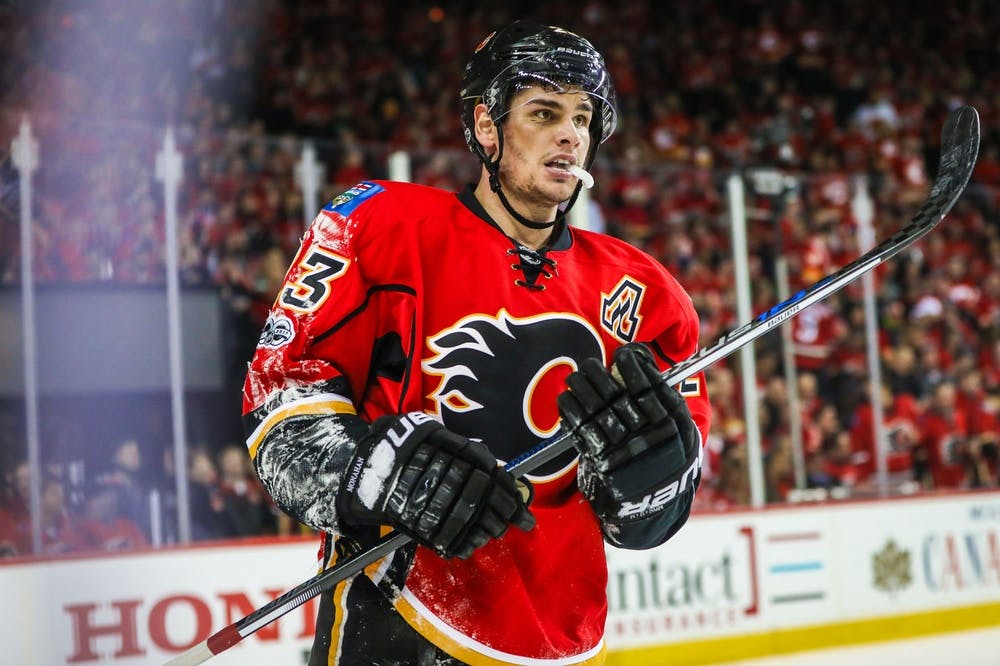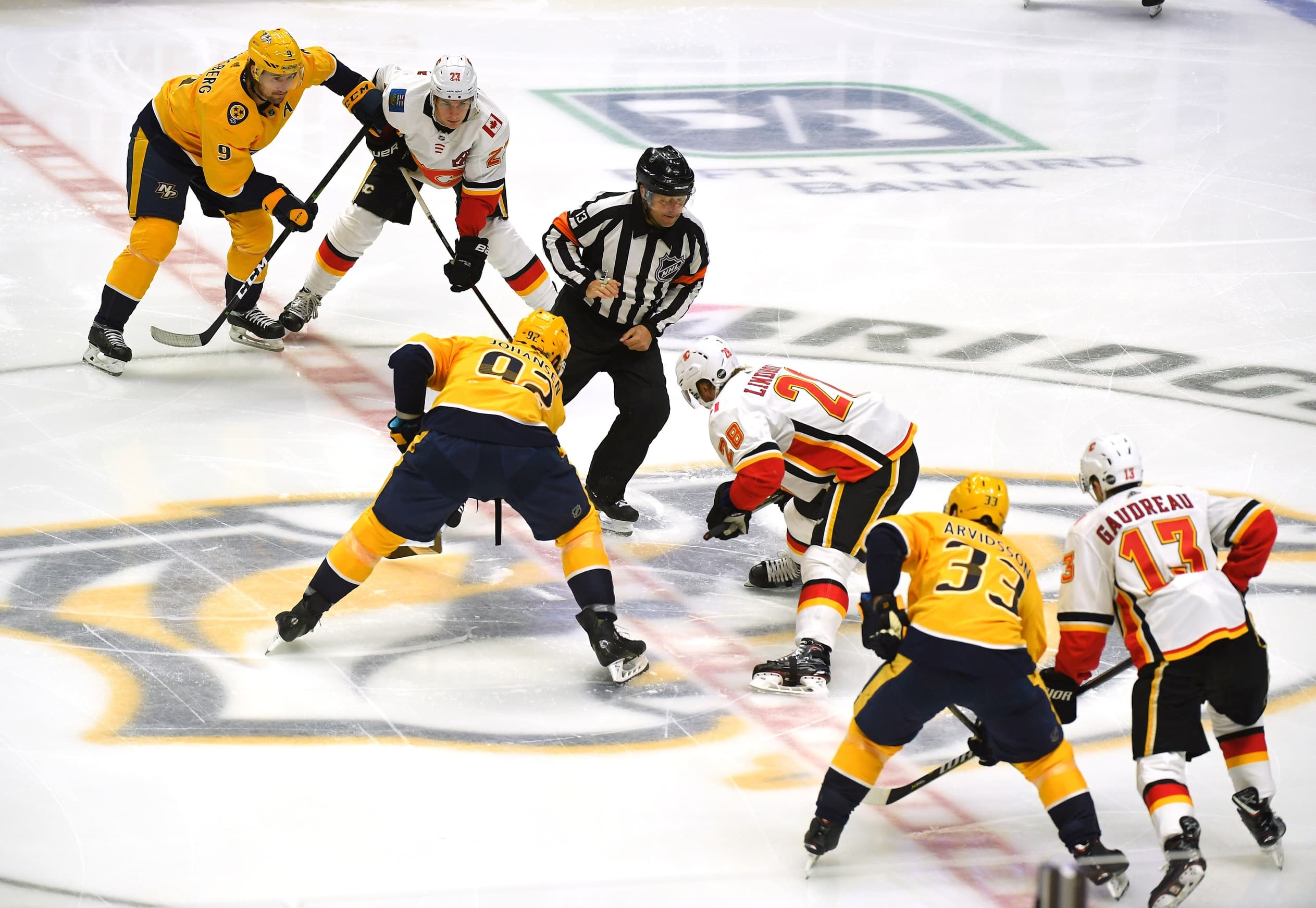Flamesnation player evaluation: Sean Monahan

By Craig Petter
3 years agoOnce an established NHL player creeps into his prime, his career path confronts a bit of a three-tined fork where the ensuing seasons test the expectations set by his early years:
1. First, his production, role, and impact can peak as he embodies every fantasized hope flung by fans on his draft day, continuing to climb.
2. Or, he can alternatively plateau and simply maintain the same respectable rates and patterns he posted as a youngster.
3. But, tragically, folks can also witness a player’s output and stock plummet in his mid-to-late 20s as he fails to recapture any of the previous promising success he found early.
2. Or, he can alternatively plateau and simply maintain the same respectable rates and patterns he posted as a youngster.
3. But, tragically, folks can also witness a player’s output and stock plummet in his mid-to-late 20s as he fails to recapture any of the previous promising success he found early.
As a 25-year-old completing his seventh (!) NHL season, Sean Monahan slipped into that crucial middle third of his career this past year where all successful players triumph, teeter, or topple. In other words, he pulled up to the fork. He has entered the cusp of his prime where careers are defined. So, according to his play for the Calgary Flames this past season, to which fork does Monahan seem to be veering? Is he still peaking, now plateauing, or newly plummeting?
Well, Sean Monahan is an infamously streaky hockey player. And this season largely represented a prolonged slump for a premier NHL scorer the year before, a blip of uncertainty for someone who struck everyone as a unanimous first-line centre in the league, a harrowing dip for a heralded offensive talent. In other words, it will likely figure somewhere between a plateau and a plummet in the narrative of his career. It was a decent though underwhelming season on the scoresheet. It was an improved though quiet season in the dirty areas. But it was ultimately a seminar in how one cannot judge a player’s long-term worth by one single season.
For the optimists out there, this means that the recent season showcased a struggling Monahan who will revert back to his crease-crowding, rebound-ramming self in no time. The 2019-20 campaign was the anomaly. For the pessimists out there, it revealed the true colours of a solid second-line centreman that flirted with stardom a while back but never slapped a ring on it. The 2018-19 season was the anomaly. Regardless, Sean Monahan stumbled this past year and shifted from an exclamation point to a question mark, and only some more time in his prime will show us which version finishes the actual sentence—or which fork he will truly take.
2019-20 season summary
(Data courtesy of NaturalStatTrick)
| Games played | Goals | Assists | Points | TOI/GP | 5v5 CF% | 5v5 CF% rel | OZF% | PDO |
| 70 | 22 | 26 | 48 | 18:06 | 49.52 | -1.02 | 57.85 | 0.986 |
Though the pause robbed Monahan of twelve remaining scheduled games during which he could pad his stats a tad, his projected output in that span still supports the fact that this year entailed his worst offensive numbers since his rookie season. A sum of 22 goals matches his first year in the league as a 19-year-old, though his pace would have netted him an extra four to finish off at 26 total—still the lowest since his rookie output, disrupting a streak of two consecutive seasons crossing the 30-goal threshold. He ranked third among all Flames in goals. As a playmaker, Monahan again posted the fewest assists of his post-teenaged career. But he was on pace for a total of 31 helpers, which is routine for Monahan, a digit he has hit twice before. He also failed to crack 50 points for the first time since his rookie year in the shortened season, but his yearlong clip suggested he would have hovered around 56 total on the year. Still, in whichever alternate universe the pandemic never happens and the NHL completes the season as usual, Monahan trends towards his worst production level in six years.
Analytically, Sean Monahan also boasted the solid but subdued numbers of a secondary scorer as opposed to an elite marksman. His on-ice even-strength xGF measured fourth among all Flames forwards, the same slot he occupied in assists, total points and points-per-game. So, though he converted at a much slower clip than usual, it was not for a unique lack of quality scoring opportunities. The entire forward group struggled to score as much as they have before, period, and no single forward among Monahan, Johnny Gaudreau, or Matthew Tkachuk is solely to blame.

Where the underlying metrics behind Monahan’s scoring did fall in the entire Flames pecking order, however, was PDO. Of all the Flames forwards who played 45 games or greater this past season, Monahan had the third-lowest PDO, meaning the sum of the team’s shooting percentage and save percentage during his shifts trailed the same stat line trailed nine regular forwards. So Monahan was as luckless as he was unproductive this season, as the Flames laboured to score while he was on the ice no matter how much they peppered the opposition.
The top line of Monahan, Gaudreau and Elias Lindholm, which was more or less unbroken all season save for a brief stretch when Lindholm swapped places with Mikael Backlund to pivot Tkachuk and Andrew Mangiapane, also sagged defensively this past year. Monahan finished with the second-highest on-ice xGA on the team, naturally conceding the second-most high-danger chances, too. No wonder he and Gaudreau led the team in their share of offensive starts.
But all harangues aside, Monahan actually had the best year of his professional life in terms of physical play. Despite the pause he still crushed his previous single-season hit total, logged his first NHL fight. Now, he is oceans away from earning any distinction as a grimy, gravelly, gritty, hockey player. Monahan still tends to just park himself in the slot, pounce on loose pucks. But he was less averse to sacrificing his body and rattling this glass this past year than ever before. Perhaps it manifested through trying to round out his game, expand his role, refine his reliability. Perhaps it accounted for his offensive plunge. But, if that were the case, do the perks stemming from extra thirty hits offset the perils of losing ten goals over the course of the year…
Compared with last season
As a sequel, this season was a critical and box-office disappointment thanks to the awe and acclaim aspired by the original—reminiscent of such comparative burnouts as Meet the Fockers, Speed 2, and Caddyshack II. But that assessment is actually unfair to Monahan since this past season was still a decent offensive showing, in the grand scheme of things, and nowhere near as atrocious as those movies.
In fact, most jabs aimed at Monahan this past season came from those indignant fists that expected him to mirror his magnificence from the 2018-19 campaign. After all, his linemates and ice-time and offensive zone deployment and power play usage never changed. Yet Monahan scored 12 fewer goals and a whopping 34 fewer points in only 8 fewer games. What haunts Sean Monahan this off-season is not only the fact that his play regressed, but it regressed so suddenly.

Remember snapshots like this? Everything just clicked in 2018-19 for him. He had a mammoth 49.81 on-ice even-strength xGF, a pristine 53.71 CF% (far superior to this past season where he wallowed in the red), and a solid PDO of 1.003 over the course of the season. The Flames posted exactly 82 more HDCF that year with Monahan twirling around the offensive zone than they did this past season. It was a stellar year, the height of his career thus far, obliterating his previous personal records for assists and points despite hobbling through a horrendous stretch of only 3 points in 8 games late in the season.
Before that season, he always hovered around the 25-30 goal and 55-65 point ranges. Then he erupted. Then the magma all cooled and the fallout from the blast was a return to his earlier output, good but not phenomenal, much to the shock and chagrin of Flames fans everywhere.
What about next season?
Well, as a prequel, there is a slight but tangible risk that this past season preceded a foreign spinoff. He has three years left on his contract at an AAV of $6.375 million per year, so the mere thought of free agency at this time wavers on the distant horizon. But the Flames seem to be preparing for some lineup changes—possibly twitches, possibly tweaks, possibly a total remodel—that will doubtlessly involve their core group. The future needs paving, and tar costs players. So, whispers of Monahan as a potential trade option have been swirling about Twitter for a while now. It is not at all a guarantee—the man is an alternate captain—but folks are hollering nonetheless for a new, incontestable number-one centre.

For if the Flames keep Monahan and he mimics this past mundane season on the scoresheet, it will cement his status as a second-line centre in the NHL—still skilled, impactful, valuable, well above-average, but just shy of elite. There is nothing wrong with that at all, but the Flames will need to wrestle and grapple with the fact that they have a second-tier player occupying a first-tier role. Unless Monahan resurges, reactivates, doubles down on the dominance he displayed all year long in 2018-19, he will remain more of a Nazem Kadri or a David Krejci (positionally, not stylistically) type than an Aleksander Barkov or a Patrice Bergeron (again, positionally as a 1C and not stylistically). And so this next season, in the throes of his prime, Monahan will either plateau or peak again—and this path will probably prove permanent.
2020 Player Evaluations

Recent articles from Craig Petter





